Filter by
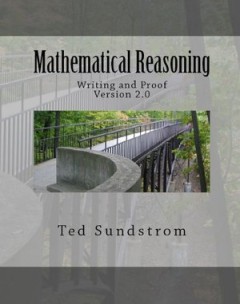
Mathematical Reasoning Writing and Proof, Version 2.0
Mathematical Reasoning: Writing and Proof is designed to be a text for the first course in the college mathematics curriculum that introduces students to the processes of constructing and writing proofs and focuses on the formal development of mathematics.The primary goals of the text are to help students:Develop logical thinking skills and to develop the ability to think more abstractly in a p…
- Edition
- -
- ISBN/ISSN
- -
- Collation
- -
- Series Title
- -
- Call Number
- -
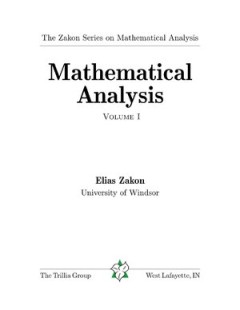
Mathematical Analysis, Volume 1 The Zakon Series on Mathematical Analysis
This text grew out of the lecture notes from the author at the University of Windsor and was originally copyrighted in 1975. It is now published by the Trillia Group, a publishing company started by his son-in-law, Bradley Lucier, a professor of mathematics and computer science at Purdue. The level of the book is appropriate for a rigorous analysis course. The author writes in the introduction …
- Edition
- -
- ISBN/ISSN
- -
- Collation
- -
- Series Title
- -
- Call Number
- -
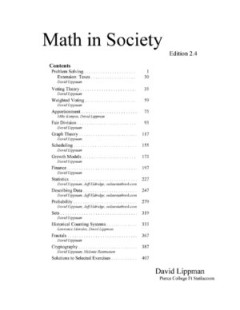
Math in Society
In this textbook there are fourteen chapters that are mostly indpendent of each other. For a typical semester course the instructor can choose several of the sections but would not be able to cover all of them. The text is full of exercises and activities to keep the students actively engaged. Each chapter has a number of short videos to emphasize the key ideas or show how to solve examples.
- Edition
- -
- ISBN/ISSN
- -
- Collation
- -
- Series Title
- -
- Call Number
- -
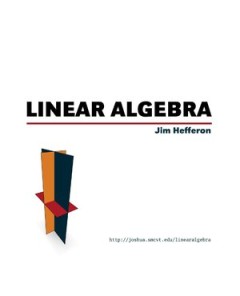
Linear Algebra, Theory and Applications
This is a book on linear algebra and matrix theory. While it is self contained, it will work best for those who have already had some exposure to linear algebra. It is also assumed that the reader has had calculus. Some optional topics require more analysis than this, however.This book features an ugly, elementary and complete treatment of determinants early in the book. Thus it might be consid…
- Edition
- -
- ISBN/ISSN
- -
- Collation
- -
- Series Title
- -
- Call Number
- -
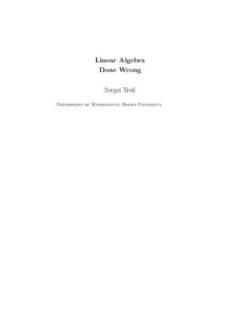
Linear Algebra Done Wrong
Brown University has two introductory linear algebra courses. This text is used in the honors course that emphasizes proofs. The book’s title suggests that it is not the typical approach to linear algebra even among those books that are more theoretical.For example, the concept of a basis is treated as more fundamental than the concept of linear independence, and linear transformations are in…
- Edition
- -
- ISBN/ISSN
- -
- Collation
- -
- Series Title
- -
- Call Number
- -
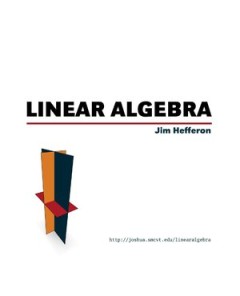
Linear Algebra
This book has the standard content of a course for science, math and engineering students that follows calculus. A semester of calculus is the explicit prerequisite, but most students would have three semesters of calculus and for them some of the beginning sections of the book can be skipped. Each chapter ends with three or four applications of that chapter’s subject.From the author’s desc…
- Edition
- -
- ISBN/ISSN
- -
- Collation
- -
- Series Title
- -
- Call Number
- -
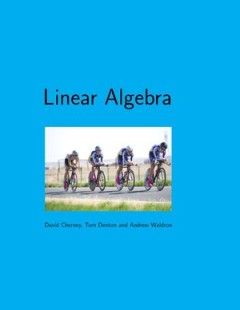
Linear Algebra
We believe the entire book can be taught in 25 50-minute lectures to a sophomore audience that has been exposed to a one year calculus course. Vector calculus is useful, but not necessary preparation for this book, which attempts to be self-contained. Key concepts are presented multiple times, throughout the book, often first in a more intuitive setting, and then again in a definition, theorem,…
- Edition
- -
- ISBN/ISSN
- -
- Collation
- -
- Series Title
- -
- Call Number
- -
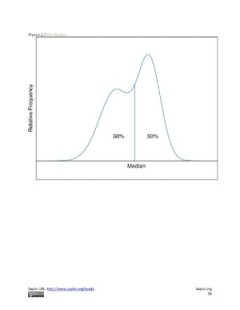
Introductory Statistics
In many introductory level courses today, teachers are challenged with the task of fitting in all of the core concepts of the course in a limited period of time. The Introductory Statistics teacher is no stranger to this challenge. To add to the difficulty, many textbooks contain an overabundance of material, which not only results in the need for further streamlining, but also in intimidated s…
- Edition
- -
- ISBN/ISSN
- -
- Collation
- -
- Series Title
- -
- Call Number
- -
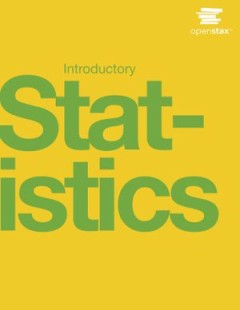
Introductory Statistics
Introductory Statistics follows the scope and sequence of a one-semester, introduction to statistics course and is geared toward students majoring in fields other than math or engineering. This text assumes students have been exposed to intermediate algebra, and it focuses on the applications of statistical knowledge rather than the theory behind it. The foundation of this textbook is Collabora…
- Edition
- -
- ISBN/ISSN
- -
- Collation
- -
- Series Title
- -
- Call Number
- -
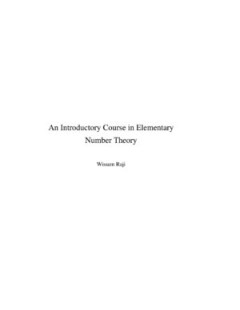
An Introductory Course in Elementary Number Theory
These notes serve as course notes for an undergraduate course in number theory.Most if not all universities worldwide offer introductory courses in numbertheory for math majors and in many cases as an elective course.The notes contain a useful introduction to important topics that need to be addressedin a course in number theory. Proofs of basic theorems are presented inan interesting and compr…
- Edition
- -
- ISBN/ISSN
- -
- Collation
- -
- Series Title
- -
- Call Number
- -
 Computer Science, Information & General Works
Computer Science, Information & General Works  Philosophy & Psychology
Philosophy & Psychology  Religion
Religion  Social Sciences
Social Sciences  Language
Language  Pure Science
Pure Science  Applied Sciences
Applied Sciences  Art & Recreation
Art & Recreation  Literature
Literature  History & Geography
History & Geography